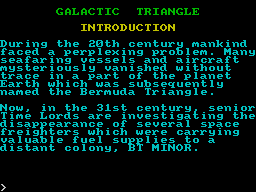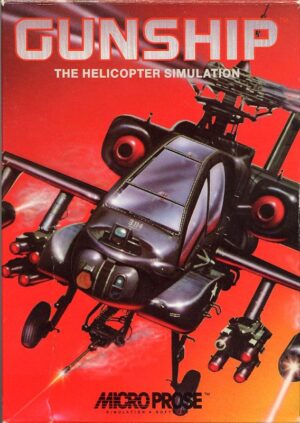Retro Replay Review
Gameplay
Doctor Goo and the Samorons delivers a classic text-adventure experience, inviting players to assume the role of its quirky protagonist by typing commands into a simple parser. Players must explore varied environments—from the cramped confines of the Tuberider Time Capsule to the sprawling, neon-bathed surface of Samoron Prime—by issuing straightforward commands like “go north,” “examine console,” or “use sonic spoon.” The parser does a commendable job interpreting a range of synonyms, minimizing frustrating “I don’t understand” moments, though occasionally you’ll need to experiment with alternate phrasing to progress.
(HEY YOU!! We hope you enjoy! We try not to run ads. So basically, this is a very expensive hobby running this site. Please consider joining us for updates, forums, and more. Network w/ us to make some cash or friends while retro gaming, and you can win some free retro games for posting. Okay, carry on 👍)
Puzzles range from logic-based riddles—such as realigning the time screw segments in proper sequence—to inventory-centric challenges like combining items in unconventional ways (ever tried sonic-wrenching a gelatinous doohickey?). The difficulty curve feels well-tuned: early brainteasers introduce the mechanics gently, while later challenges demand real creativity and attention to environmental clues. Hints are cleverly woven into descriptive text, rewarding players who take time to read every line rather than rushing through.
One of the game’s most endearing features is its sense of humor. Doctor Goo’s internal monologue frequently breaks the fourth wall, commenting on the absurdity of your own commands (“Sure, let me just ‘zap’ that suspicious banana.”). These comedic interjections not only provide levity but occasionally double as subtle nudges toward the next solution. Additionally, the inclusion of optional humorous side quests encourages exploration, as you might unearth comedic subplots involving Samoron bureaucrats or misfiring TARDIS knockoffs.
Controls are entirely keyboard-driven, which may feel antiquated to some modern adventurers, but veteran text-adventure fans will appreciate the purity of the interface. The game autosaves at key junctures, though manual saving remains available, allowing you to experiment freely before committing to major decisions. Overall, the gameplay loop of exploration, puzzle-solving, and witty dialogue creates a rhythm that’s both nostalgic and entertaining for newcomers and genre veterans alike.
Graphics
As a predominantly text-based adventure, Doctor Goo and the Samorons places the emphasis on descriptive prose rather than high-definition visuals. Nevertheless, the minimalist ASCII artwork that occasionally appears—such as schematic diagrams of alien machinery or stylized representations of your time machine’s control panel—enhances the sense of atmosphere without overwhelming the imagination. These occasional visual flourishes feel like Easter eggs, rewarding those who appreciate retro aesthetics.
The user interface is clean and uncluttered. Your command prompt and the scrolling text window occupy the center of the screen, while a small status bar at the top discreetly shows your current location, inventory capacity, and puzzle hints (if you elect to enable them). This layout strikes a balance between preserving immersion and providing just enough information to keep you oriented in complex environments.
Text styling—such as boldface for key objects or italicized commentary for comedic asides—helps important details stand out during lengthy room descriptions. Color usage is sparing but effective: vivid palettes highlight danger zones, while muted tones indicate safe areas or puzzle-neutral spaces. Although some players might wish for hand-drawn illustrations or animated sequences, the game’s aesthetic charm lies precisely in what it omits, allowing your mind to paint scenes based on richly detailed narration.
For those seeking accessibility, font size adjustments and contrast options ensure readability on a variety of displays. Whether you’re playing on a compact laptop or a large desktop monitor, the text remains crisp and easy on the eyes. In a genre where imagination reigns supreme, Doctor Goo and the Samorons demonstrates that graphics need not be elaborate to be effective—sometimes the clearest window into another world is the written word itself.
Story
At its core, Doctor Goo and the Samorons is a comedic sci-fi yarn in which you, as Doctor Goo, must thwart the galaxy-spanning ambitions of the nefarious Samoron race. Although the game is an unofficial homage to classic text adventures—particularly those bearing the Doctor Who license—the narrative stands on its own, populated by new characters with punny names and offbeat personalities. Every planet you visit reveals a fresh chapter in the overarching conspiracy, punctuated by memorable NPCs ranging from disgruntled space librarians to malfunctioning robot DJs.
The writing sparkles with wit, capturing the spirit of witty banter and slapstick humor. Dialogue trees are peppered with multiple-choice retorts, some of which unlock hidden jokes or alternate puzzle solutions. Characters react differently based on your tone—choose the flippant remark, and you might face a comedic scolding; opt for earnest empathy, and you could gain an unexpected ally. These branching interactions add replay value, encouraging you to revisit key decision points just to see how the story diverges.
Despite its humor, the plot maintains a surprisingly cohesive throughline. Subplots involving stolen time-energy crystals, misplaced Sentient Jelly Geodes, and bureaucratic infighting within the Samoron High Council eventually converge in a climactic showdown that tests both your wits and your sense of timing. The pacing is deliberate yet brisk, striking a balance between leisurely exploration and narrative urgency. Plot twists are telegraphed just enough to feel fair, yet still manage to surprise when you least expect them.
The game also sprinkles in affectionate nods to Doctor Who lore without relying on deep fan knowledge. You’ll spot playful references—like a gaudily decorated console room reminiscent of the TARDIS interior or a companion named “Sal” who reminds you of a certain blue box—but these Easter eggs enrich the experience rather than alienate newcomers. Whether you’re a die-hard Whovian or a first-time text-adventure player, the story stands as its own amusing and satisfying sci-fi romp.
Overall Experience
Doctor Goo and the Samorons offers a delightful blend of nostalgia and fresh humor, serving both as a love letter to classic text adventures and as a standalone comedic sci-fi journey. Its intuitive parser, well-paced puzzles, and engaging storytelling make for a highly replayable package. You’ll likely find yourself chuckling at the on-the-fly jokes and mentally retracing clues long after you log off.
Replayability is one of the game’s greatest assets. Multiple puzzle solutions, branching dialogue options, and hidden side quests ensure that a second playthrough will reveal new surprises. The relatively modest length—around 6 to 8 hours for a standard run—strikes a sweet spot, offering enough content to feel substantial without overstaying its welcome. Time investment feels fair given the game’s price point, which positions it attractively for budget-minded gamers or those simply curious about interactive fiction.
Community support is another highlight: an active forum of fellow players shares hints, jokes, and fan-made walkthroughs, creating a welcoming environment for newcomers. Regular developer updates have addressed parser quirks and added bonus puzzles, demonstrating a commitment to improving the experience long after launch. For those who appreciate a game that evolves with its audience, Doctor Goo and the Samorons stands out in the crowded indie scene.
In sum, whether you’re longing for the golden age of text adventures or simply in search of a cleverly written sci-fi comedy, Doctor Goo and the Samorons delivers. It’s an accessible, laugh-out-loud romp that invites you to flex your brain, tickle your funny bone, and save the galaxy—all through the power of typed words.
 Retro Replay Retro Replay gaming reviews, news, emulation, geek stuff and more!
Retro Replay Retro Replay gaming reviews, news, emulation, geek stuff and more!






Reviews
There are no reviews yet.